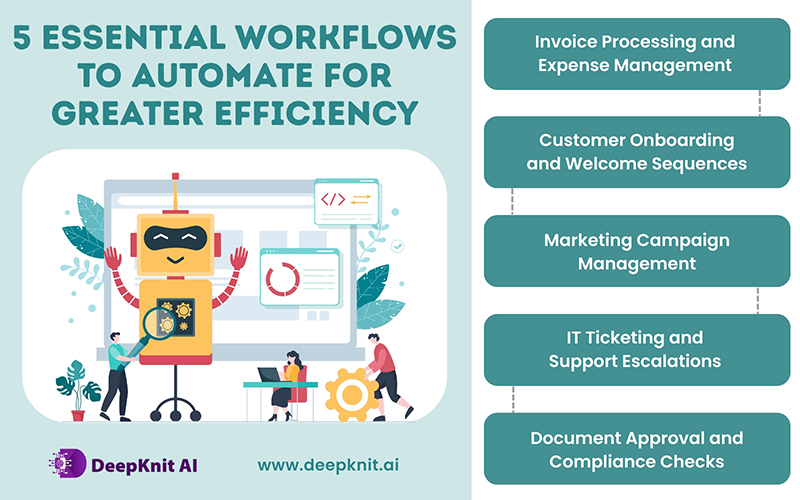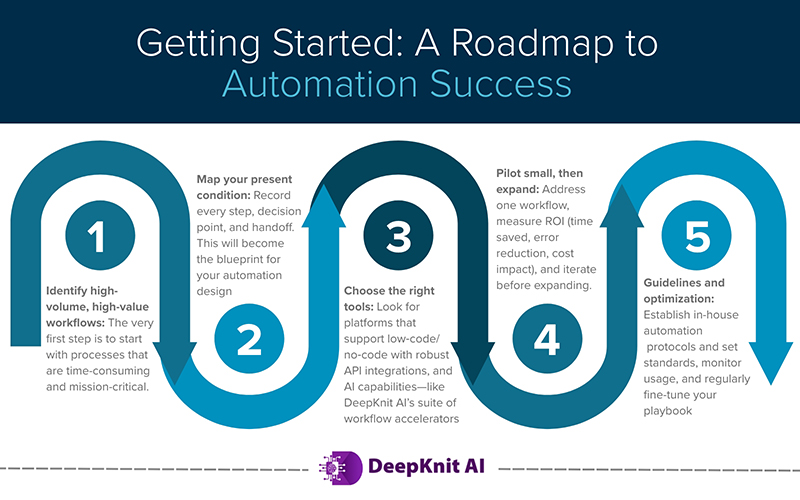It was predicted that by 2025, at least 80% of organizations would have adopted intelligent automation, thereby reshaping the way operations are handled across every department.
Even then, 54% of office workers still spend their valuable time manually searching for files on their actual jobs rather than doing something productive, underlining a massive opportunity for improvement through workflow automation.
In the present fast-moving business ecosystem, having an automated solution is not a gimmick to woo your clients, but rather a strategic imperative to stay relevant. Freeing your team from the shackles of manual drudgery grants you ample time and capacity for creative and high-value activities at work—regardless of whether you’re a Fortune 500 enterprise or a fledgling startup.
In this post, we shall walk through the top workflows to automate in order to improve business efficiency, discuss the tangible benefits, and demonstrate how cutting-edge AI solutions—from Robotic Process Automation (RPA) to DeepKnit AI’s bespoke offerings—can power your next big leap in efficiency and digital transformation.
Top 5 Workflows You Should be Automating Right Now
- Invoice Processing and Expense Management
Accounts payable and expense reconciliation are notorious for gridlocking daily financial activities. Data entry errors, missed approvals, and delayed payments stress vendor relationships and surge operational costs.
What to Automate
- Invoice data capture: Leverage OCR to pull invoice numbers, dates, line items, and amounts from PDFs or scanned images.
- Approval workflows: Navigate invoices automatically over a fixed threshold to finance leads, while low value invoices follow a streamlined path.
- Exception handling: Flag mismatches like PO‑invoice discrepancies for human review, while clearing the remaining for payment.
Benefits
- Cost savings: Companies report savings from tens of thousands to several million dollars per year, depending on volume and complexity.
- Accuracy: Reduce manual entry errors by up to 90%.
- Cash‑flow optimization: Leverage early-payment discounts and maintain stronger vendor relations.
- Customer Onboarding and Welcome Sequences
First impressions are what set the tone for the rest of the business process. A seamless onboarding experience can improve customer satisfaction by a staggering 60%, minimize churn, and accelerate time-to-value. Even then, many organizations still rely on manual email follow-ups, PDF attachments, and human triggers; creating delays and inconsistencies.
What to Automate
- Welcome emails and resource delivery: Automatically send personalized emails with user-specific guides, tutorial videos, or login credentials as soon as a new account is activated.
- Account verification and document organization: Trigger reminders if customers haven’t submitted the required forms, auto detect missing fields, and log compliance status.
- Internal task assignment: Notify sales, support, and finance teams when a high-value customer signs up, complete with context summaries and next steps.
Benefits
- Consistency: Ensure every customer gets the same high-quality, on-brand materials.
- Speed: Reduce “time to first value” from days to minutes.
- Scale: Handle spikes in new sign-ups without adding headcount.
- Marketing Campaign Management
Modern marketing teams slave away handling email drip campaigns, social media scheduling, lead scoring, and performance reporting, all of which can quickly become exhausting, especially when done by hand.
What to Automate
- Drip email sequences: Activate personalized sequences based on user behavior (e.g. link clicks, page visits), ensuring messages are sent promptly.
- Social media posting: Schedule and cross post content across all social media platforms with unified calendars and approvals.
- Lead enrichment and scoring: Automatically enrich leads with firmographic data and assign scores for faster hand-off to sales.
Benefits
- Higher engagement: Timely, relevant content drives click-through rates up by as much as 50%.
- Data-driven decisions: Free up analysts from tedious data wrangling to focus on strategy.
- Consistency across channels: Maintain a unified brand voice without manual effort.
- IT Ticketing and Support Escalations
Helpdesk teams process hundreds or sometimes thousands of query tickets every week. However, slow response times frustrate employees and customers alike, while high-priority issues may slip through the cracks.
What to Automate
- Ticket triage and routing: Use Natural Language Processing (NLP) to categorize tickets (e.g. “password reset,” “software bug,” “hardware failure”) and assign them to the appropriate resolver team.
- Standard responses: Auto reply to common queries (like password resets or software installation), including step-by-step guides or secure links.
- SLA monitoring: Trigger escalation alerts if tickets aren’t addressed within defined thresholds.
Benefits
- Quicker resolution: Immediate replies for routine issues can cut mean time to resolution (MTTR) by up to 40%.
- Better resource allocation: Technicians focus on complex problems, while bots handle the mundane.
- Improved satisfaction: Employees and customers love swift, continuous support.
- Document Approval and Compliance Checks
From legal contracts to policy updates, many enterprises rely on multi‑stage approval chains that can drag on for weeks. Manual reminders, version conflicts, and miscommunications introduce risk and delay.
What to Automate
- Version control: Automatically detect the latest document in your repository (e.g. SharePoint, Google Drive) and lock outdated drafts.
- Sequential approvals: Enforce business rules—such as “finance must approve before legal”—and send notifications at each stage.
- Audit trails: Maintain immutable logs of who approved what and when, ensuring full compliance with regulatory requirements.
Benefits
- Reduced cycle times: Approval processes that once took days can be completed in hours.
- Risk mitigation: Automated checks for missing clauses or unauthorized changes prevent non-compliance.
- Transparency: Clear dashboards show where bottlenecks occur and who needs to act next.
Why Collaborate with DeepKnit AI?
Modern workflow automation goes beyond simple rule‑based bots. It requires contextual understanding, adaptive intelligence, and seamless integration with your existing systems. That’s where DeepKnit AI comes in:
- Custom AI Solutions: From NLP‑driven ticket triage to document intelligence, our models are fine‑tuned on your domain data.
- Rapid Deployment: Low‑code connectors and pre‑built templates get you up and running in weeks, not months.
- Continuous Learning: Our AI learns from every interaction, improving accuracy and efficiency over time.
- Enterprise‑grade Security: SOC 2 compliance, end‑to‑end encryption, and rigorous governance ensure your data stays safe.
Final Thoughts
We’re now standing right at the doorstep opening towards a workplace revolution—one not defined by more hours or more hires, but by smarter, leaner, AI-assisted operations. The organizations that continue to rely on manual workflows are already two steps behind. Every manually routed email, every manually reviewed report, and every manually categorized customer ticket is a missed bus rolling towards growth, innovation, and efficiency.
The five workflows we’ve explored here: customer onboarding, invoice processing, marketing campaigns, IT ticketing, and document approvals, represent just the tip of the automation iceberg. These are high-impact processes that, once automated, not only mitigate operational friction but unravel measurable ROI almost immediately.
But here’s the bigger picture: when you augment your operations with intelligent automation, especially AI-powered platforms that can understand context, language, and nuance, you’re not just optimizing processes. You’re future-proofing your business.
And that’s where working with the right AI partner becomes critical – it can improve business efficiency with automation tools, like DeepKnit AI.
Turn hours of manual work into minutes
Automate your workflows and reclaim your team’s time
Contact Us



